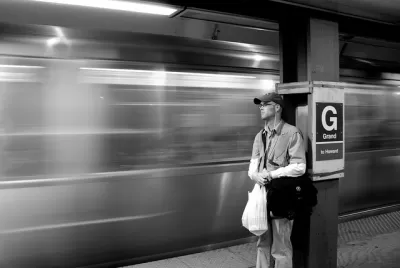While transit agency data shows ridership going down, Census data shows ridership going up. Why?

Over the past couple of years, I have seen quite a bit of commentary about declining public transit ridership (for example, here and here [pdf]). This view seems to be backed up by American Public Transit Association (APTA) ridership statistics, which are based on figures complied by transit agencies. APTA data shows that in 2018, U.S. transit passenger trips declined by 2 percent from the previous year, to 9.8 million, a 9 percent decline from transit's 21st-century peak in 2014. Transit agencies appear to have lost all the riders they gained during the early 2010s.*
However, estimates from the Census Bureau's American Community Survey (ACS) paint a very different picture. The most recent ACS 5 year estimate (based on surveys conducted from 2013-17) shows 7.6 million transit riders nationwide, up from 7.1 million in the 2010-14 estimate.
Even in some of the cities where transit ridership has decreased the most, ACS data shows rising transit ridership. For example, APTA data shows that Washington, D.C.’s subway ridership declined from 271 million in 2014 to 226 million in 2018—a 16 percent decline at a time when national heavy rail ridership declined by only 5 percent. Similarly, Washington's Metrobus ridership declined by 18 percent (from 134 million to 109 million) while national bus ridership declined by about 11 percent.
Yet according to the ACS survey, ridership rose in Washington. In the District of Columbia, ridership rose by about 5000 people during this period (from just over 120,000 to just over 125,000). ACS data also shows modest ridership increases in the two largest suburban counties, Montgomery County (Maryland) and Fairfax County (Virginia).
And in Cleveland, Ohio, APTA data shows that ridership on RTA (the region’s major transit agency) declined from 49 million in 2014 to 31 million in 2018. Yet ACS data show that in Cuyahoga County, Ohio (which includes most of the RTA service area) the number of riders decreased from 28,111 to 27,659—a change that was within the survey’s statistical margin of error
What's going on? Perhaps more people are riding transit but each transit rider is taking fewer trips; this would be the case if (for example) regular transit riders chose to drive or take taxis for non-work trips, thus reducing the overall number of transit trips. Or maybe the ACS is wrong or outdated. Your thoughts?
*However, transit ridership is still above early 2000s levels. 2000 transit ridership was 9.4 million, and 1996 ridership was only 7.9 million. I also note that ridership continues to increase in Canada.

Alabama: Trump Terminates Settlements for Black Communities Harmed By Raw Sewage
Trump deemed the landmark civil rights agreement “illegal DEI and environmental justice policy.”

Planetizen Federal Action Tracker
A weekly monitor of how Trump’s orders and actions are impacting planners and planning in America.

The 120 Year Old Tiny Home Villages That Sheltered San Francisco’s Earthquake Refugees
More than a century ago, San Francisco mobilized to house thousands of residents displaced by the 1906 earthquake. Could their strategy offer a model for the present?

Opinion: California’s SB 79 Would Improve Housing Affordability and Transit Access
A proposed bill would legalize transit-oriented development statewide.

Record Temperatures Prompt Push for Environmental Justice Bills
Nevada legislators are proposing laws that would mandate heat mitigation measures to protect residents from the impacts of extreme heat.

Downtown Pittsburgh Set to Gain 1,300 New Housing Units
Pittsburgh’s office buildings, many of which date back to the early 20th century, are prime candidates for conversion to housing.
Urban Design for Planners 1: Software Tools
This six-course series explores essential urban design concepts using open source software and equips planners with the tools they need to participate fully in the urban design process.
Planning for Universal Design
Learn the tools for implementing Universal Design in planning regulations.
Clanton & Associates, Inc.
Jessamine County Fiscal Court
Institute for Housing and Urban Development Studies (IHS)
City of Grandview
Harvard GSD Executive Education
Toledo-Lucas County Plan Commissions
Salt Lake City
NYU Wagner Graduate School of Public Service




























